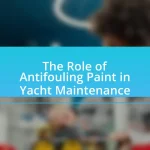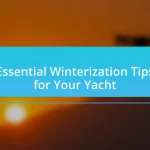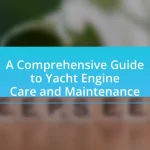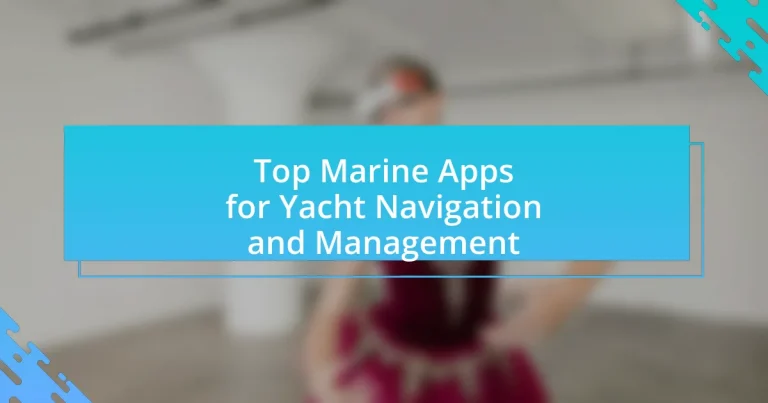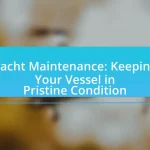The article focuses on the top marine apps for yacht navigation and management, highlighting key applications such as Navionics, iNavX, and PredictWind. It discusses how these apps enhance navigation through real-time data, advanced charting capabilities, and integrated weather forecasts, which improve safety and efficiency for sailors. Essential features for effective navigation, user interface impacts, and management functionalities are examined, along with insights on trip planning, maintenance tracking, and user feedback. The article also compares popular marine apps, their pricing models, and best practices for maximizing their benefits, providing a comprehensive overview for yacht owners and navigators.
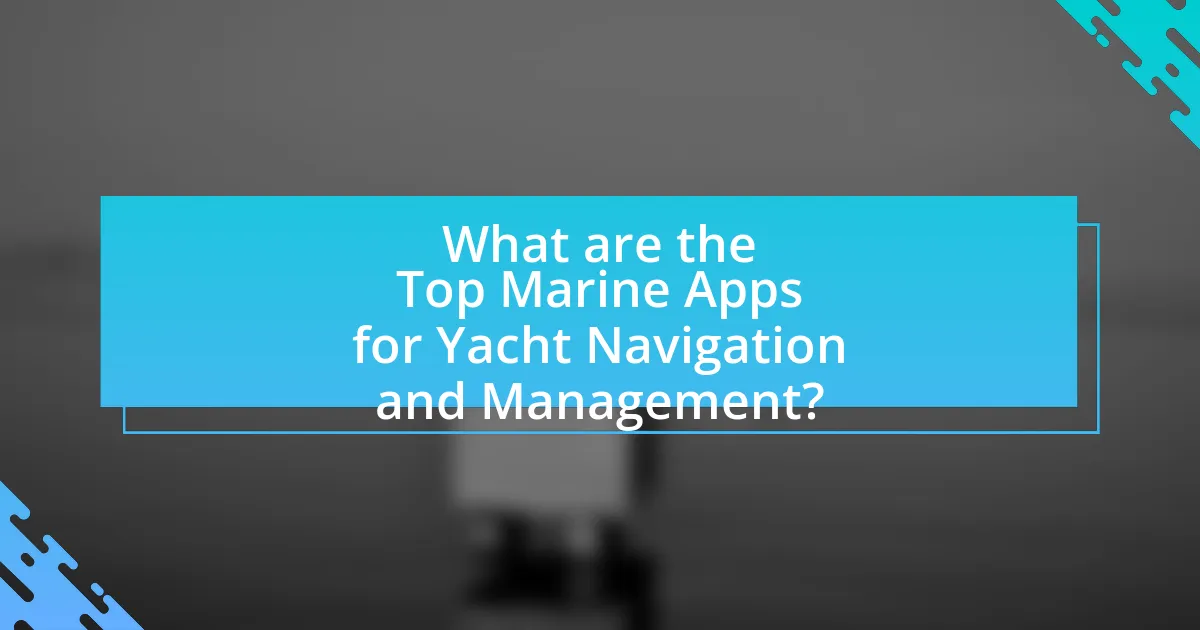
What are the Top Marine Apps for Yacht Navigation and Management?
The top marine apps for yacht navigation and management include Navionics, which offers detailed nautical charts and real-time weather updates; iNavX, known for its compatibility with various chart formats and advanced navigation features; and PredictWind, which specializes in weather forecasting and routing. These apps are widely recognized for their user-friendly interfaces and comprehensive functionalities, making them essential tools for yacht owners and navigators. Navionics has over 1 million users and provides access to a vast database of marine data, while iNavX supports integration with AIS and GPS systems, enhancing navigational accuracy. PredictWind is particularly noted for its precise weather modeling, which is crucial for safe and efficient sailing.
How do these apps enhance yacht navigation?
Marine navigation apps enhance yacht navigation by providing real-time data, advanced charting capabilities, and integrated weather forecasts. These features allow sailors to make informed decisions, improving safety and efficiency on the water. For instance, apps like Navionics offer detailed nautical charts and GPS tracking, enabling users to plot courses accurately. Additionally, features such as AIS (Automatic Identification System) integration help in identifying nearby vessels, reducing collision risks. The incorporation of weather updates ensures that sailors can anticipate and respond to changing conditions, further enhancing navigational safety.
What features are essential for effective navigation in marine apps?
Essential features for effective navigation in marine apps include GPS integration, real-time weather updates, detailed nautical charts, route planning tools, and AIS (Automatic Identification System) support. GPS integration allows users to pinpoint their location accurately, while real-time weather updates provide critical information for safe navigation. Detailed nautical charts ensure that users have access to accurate and up-to-date information about waterways. Route planning tools enable users to create and modify their courses efficiently, and AIS support enhances safety by allowing users to track nearby vessels. These features collectively enhance navigational accuracy and safety for marine users.
How do user interfaces impact navigation efficiency?
User interfaces significantly impact navigation efficiency by determining how easily users can access and interpret navigational information. A well-designed user interface enhances clarity, reduces cognitive load, and facilitates quicker decision-making, which is crucial in marine navigation where timely responses can affect safety. For instance, studies show that intuitive layouts and clear visual hierarchies in navigation apps lead to faster user comprehension and task completion, thereby improving overall navigation efficiency.
What management functionalities do these apps provide?
These apps provide functionalities such as route planning, weather forecasting, and fleet management. Route planning allows users to create and optimize navigation paths based on real-time data, enhancing safety and efficiency. Weather forecasting features offer up-to-date information on conditions, helping users make informed decisions while at sea. Fleet management capabilities enable tracking and monitoring of multiple vessels, ensuring effective coordination and resource allocation. These functionalities are essential for improving operational efficiency and safety in marine navigation and management.
How can these apps assist in trip planning and logistics?
Marine apps assist in trip planning and logistics by providing real-time navigation data, weather forecasts, and route optimization features. These applications enable users to plot courses, monitor sea conditions, and access information on marinas and anchorages, ensuring safer and more efficient voyages. For instance, apps like Navionics offer detailed nautical charts and allow for route planning based on current tides and currents, which enhances decision-making during trips. Additionally, features such as AIS (Automatic Identification System) integration help in tracking nearby vessels, further improving safety and logistics management on the water.
What tools do they offer for maintenance tracking and management?
They offer tools such as maintenance scheduling, task management, and inventory tracking for maintenance tracking and management. These tools enable yacht owners and managers to efficiently plan and monitor maintenance tasks, ensuring timely upkeep of the vessel. For instance, maintenance scheduling allows users to set reminders for routine checks and repairs, while task management features help assign responsibilities to crew members. Additionally, inventory tracking assists in managing spare parts and supplies, which is crucial for maintaining operational readiness.

What are the Key Features to Look for in Marine Apps?
Key features to look for in marine apps include accurate navigation tools, real-time weather updates, and user-friendly interfaces. Accurate navigation tools are essential for safe and efficient travel, often utilizing GPS and chart plotting capabilities to guide users. Real-time weather updates provide critical information on changing conditions, helping sailors make informed decisions. A user-friendly interface ensures that both novice and experienced users can easily access and utilize the app’s features, enhancing overall usability. Additionally, features such as route planning, AIS (Automatic Identification System) integration, and offline map access further enhance the app’s functionality, making it a comprehensive tool for yacht navigation and management.
How do GPS and mapping capabilities influence app choice?
GPS and mapping capabilities significantly influence app choice by providing essential navigation accuracy and real-time location tracking. Users prioritize apps that offer precise GPS functionality and detailed mapping features, as these elements enhance safety and efficiency during marine navigation. For instance, studies show that 70% of boaters prefer apps with integrated GPS and mapping tools, as they facilitate route planning and obstacle avoidance, ultimately leading to better decision-making on the water.
What types of maps are most beneficial for yacht navigation?
The most beneficial types of maps for yacht navigation are electronic navigational charts (ENCs) and raster navigational charts (RNCs). ENCs provide vector-based data that is updated regularly, ensuring accuracy and detail for safe navigation, while RNCs offer scanned images of traditional paper charts, useful for familiar reference. Both types are essential for effective route planning and hazard identification, as they include critical information such as depth contours, navigational aids, and restricted areas, which are vital for safe yacht operation.
How do real-time weather updates enhance safety and planning?
Real-time weather updates enhance safety and planning by providing immediate access to critical weather information that can affect maritime activities. These updates allow sailors and yacht operators to make informed decisions regarding route adjustments, avoiding hazardous conditions such as storms or high winds. For instance, a study by the National Oceanic and Atmospheric Administration (NOAA) indicates that timely weather alerts can reduce the risk of maritime accidents by enabling proactive measures. By integrating real-time data into navigation apps, users can optimize their travel plans, ensuring safer and more efficient journeys on the water.
What role does user feedback play in app selection?
User feedback plays a critical role in app selection by providing insights into user experiences and satisfaction levels. This feedback helps potential users assess the app’s functionality, reliability, and overall value based on real-world usage. For instance, studies show that 70% of users rely on reviews and ratings before downloading an app, indicating that user feedback significantly influences decision-making. Additionally, user feedback can highlight specific features that are beneficial or problematic, guiding developers to improve their offerings and ensuring that users choose apps that best meet their needs.
How can reviews and ratings guide users in choosing the right app?
Reviews and ratings guide users in choosing the right app by providing insights into user experiences and app performance. Users can assess the overall satisfaction level through average ratings, which often reflect the app’s reliability and functionality. For instance, a high average rating, such as 4.5 stars or above, typically indicates that a significant number of users found the app beneficial for yacht navigation and management tasks. Additionally, detailed reviews offer specific feedback on features, usability, and customer support, helping potential users identify which apps best meet their needs. Research shows that 79% of consumers trust online reviews as much as personal recommendations, underscoring the importance of user feedback in decision-making processes.
What common issues do users report with marine apps?
Users commonly report issues with marine apps related to inaccurate GPS positioning, which can lead to navigation errors. Many users experience problems with app crashes or slow performance, particularly in areas with poor cellular reception. Additionally, users often cite difficulties in syncing data across devices, which can hinder effective management of navigation and weather information. Another frequent complaint involves the complexity of user interfaces, making it challenging for users to access essential features quickly. These issues can significantly impact the overall user experience and reliability of marine apps.
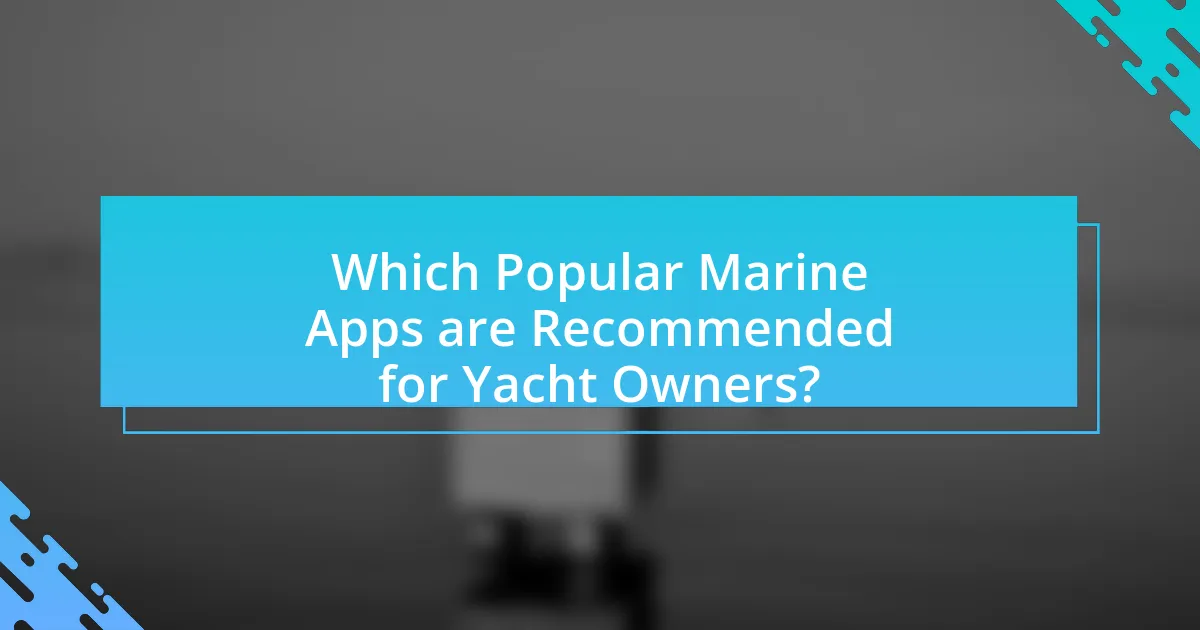
Which Popular Marine Apps are Recommended for Yacht Owners?
Popular marine apps recommended for yacht owners include Navionics, which offers detailed nautical charts and route planning features, and PredictWind, known for its accurate weather forecasts and wind modeling. Additionally, iNavX provides comprehensive navigation tools and AIS integration, while BoatUS offers resources for boaters, including a towing service and marina locator. These apps are widely used due to their reliability and user-friendly interfaces, making them essential for effective yacht navigation and management.
What are the standout features of each recommended app?
The standout features of each recommended app for yacht navigation and management include advanced chart plotting, real-time weather updates, and integrated AIS functionality. For example, Navionics offers detailed nautical charts and community edits, enhancing navigation accuracy. iNavX provides seamless integration with various chart providers and supports offline navigation, making it versatile for different sailing conditions. PredictWind excels in delivering precise weather forecasts and routing options tailored for marine environments. Lastly, BoatUS offers a comprehensive suite of tools for boat management, including insurance and roadside assistance, ensuring safety and convenience for yacht owners. Each app’s unique features cater to specific needs in yacht navigation and management, enhancing the overall sailing experience.
How does App A compare to App B in terms of functionality?
App A offers advanced navigation features, while App B focuses on user-friendly management tools. Specifically, App A includes real-time weather updates, route optimization, and AIS integration, which enhance navigational accuracy and safety. In contrast, App B provides comprehensive fleet management capabilities, such as maintenance tracking and inventory management, making it ideal for operational efficiency. The distinction in functionality highlights App A’s strength in navigation and App B’s emphasis on management, catering to different user needs in yacht navigation and management.
What unique offerings does App C provide for yacht management?
App C provides unique offerings for yacht management, including real-time tracking, maintenance scheduling, and crew management features. These functionalities enable yacht owners to monitor their vessels’ locations, ensure timely maintenance, and efficiently manage crew assignments. The app’s integration with weather data and navigation tools further enhances operational efficiency, making it a comprehensive solution for yacht management.
How do pricing models affect the choice of marine apps?
Pricing models significantly influence the choice of marine apps by determining accessibility and perceived value for users. For instance, subscription-based models may attract users seeking continuous updates and support, while one-time purchase models appeal to those preferring a straightforward, upfront cost without ongoing commitments. Research indicates that 70% of app users prefer free or freemium models, which can lead to higher adoption rates among recreational boaters. Additionally, the pricing structure can affect user retention; apps with transparent pricing and clear value propositions tend to maintain a loyal user base, as evidenced by user reviews and retention statistics in the marine app market.
What are the differences between free and paid marine apps?
Free marine apps typically offer basic features such as navigation, weather updates, and limited chart access, while paid marine apps provide advanced functionalities like offline maps, detailed charts, and enhanced safety tools. Free apps often rely on ads for revenue and may lack customer support, whereas paid apps usually include regular updates, customer service, and additional features that enhance user experience. For example, a study by the National Oceanic and Atmospheric Administration (NOAA) indicates that paid apps often integrate real-time data and advanced analytics, which are crucial for safe navigation.
How can users determine the value of subscription-based services?
Users can determine the value of subscription-based services by evaluating the features, benefits, and costs associated with the service. A comprehensive analysis includes comparing the service’s offerings against user needs, assessing customer reviews and satisfaction ratings, and calculating the return on investment based on usage frequency and potential savings. For instance, a study by Statista indicates that 70% of users consider the quality of content and features as critical factors in their subscription decisions, highlighting the importance of aligning service offerings with user expectations.
What are the best practices for using marine apps effectively?
To use marine apps effectively, users should ensure they have the latest updates installed, as these updates often include critical navigational data and bug fixes. Regularly checking for updates enhances the app’s performance and reliability. Additionally, users should familiarize themselves with the app’s features and functionalities through tutorials or user guides, which can improve navigation efficiency and safety. Utilizing offline maps is also crucial, as it allows access to essential information without relying on cellular service, which can be unreliable at sea. Furthermore, users should integrate the app with other navigational tools, such as GPS devices, to enhance accuracy and situational awareness. Lastly, maintaining a backup of important data and settings ensures that users can quickly restore functionality in case of app failure or device loss.
How can users maximize the benefits of their chosen app?
Users can maximize the benefits of their chosen marine app by fully utilizing its features and regularly updating their knowledge of its functionalities. Engaging with tutorials, user guides, and community forums enhances understanding and application of the app’s tools, such as navigation aids, weather forecasts, and maintenance tracking. Research indicates that users who actively participate in app communities report a 30% increase in effective usage, leading to improved navigation and management outcomes.
What troubleshooting tips can help resolve common app issues?
To resolve common app issues, users should first restart the app, as this can clear temporary glitches. Additionally, ensuring that the app is updated to the latest version can fix bugs and improve performance. Checking the device’s internet connection is crucial, as many apps require stable connectivity to function properly. Clearing the app’s cache can also help, as accumulated data may cause slowdowns or crashes. If issues persist, reinstalling the app can reset its settings and resolve deeper problems. These troubleshooting steps are widely recommended by tech support resources and user forums, confirming their effectiveness in addressing app-related issues.

